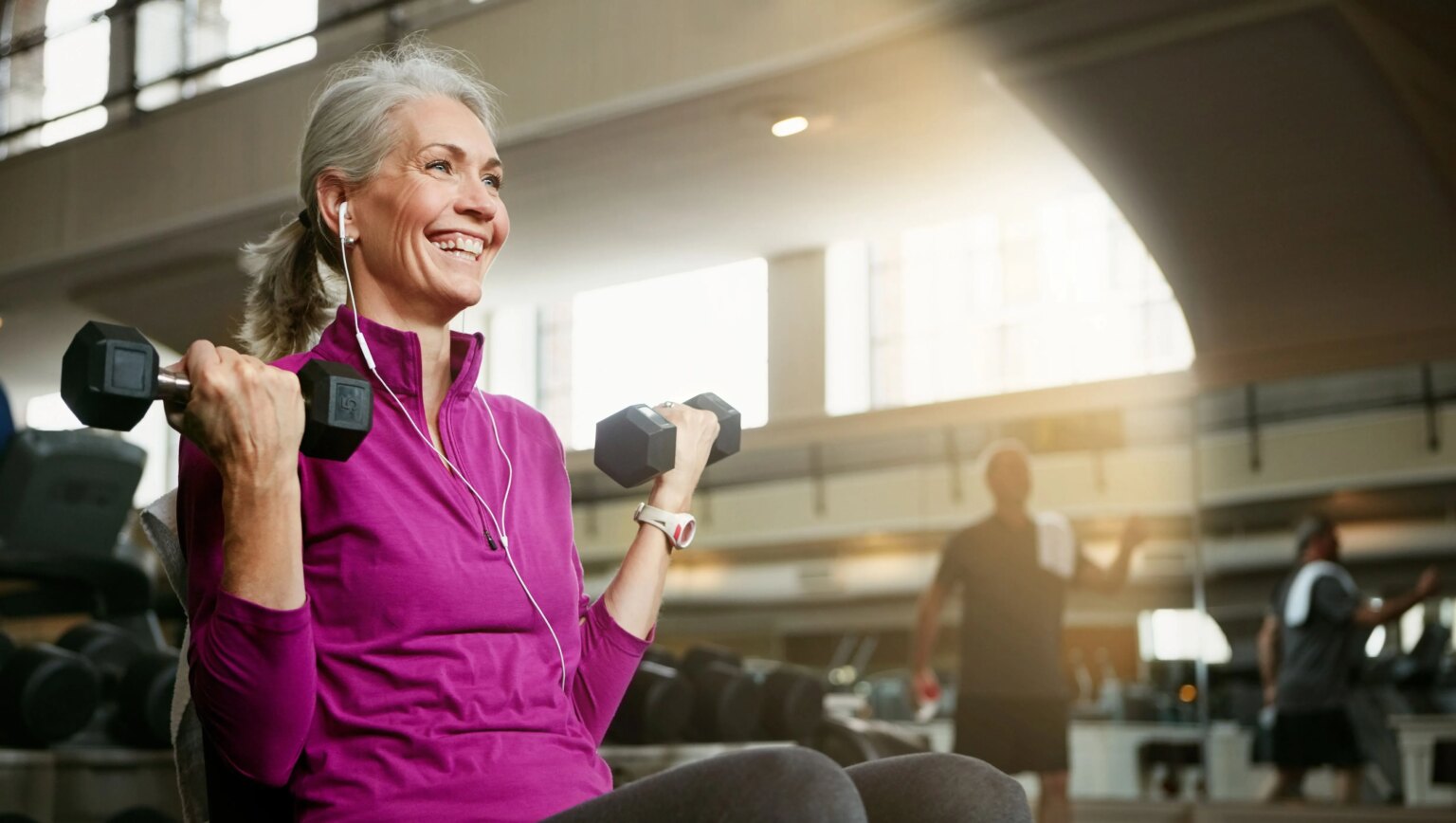Full-Body Workout to Help Manage Menopause Symptoms
All you need is set of dumbbells or a kettlebell for this workout from hormone-balancing fitness expert Debra Atkinson, CSCS, creator of Flipping 50, which helps women over 50 get and stay active. It’s a quick and simple way to target all of the major muscle groups in under 20 minutes.
Warm-Up
Do: 5 minutes of dynamic stretches and walking or jogging in place.
The Workout
Do: 15 to 20 reps for each exercise and repeat the circuit two time through. As you get stronger, increase the amount of weight and do 2 to 3 rounds of 12 to 15 reps for each exercise.
- Squat
- Bent-over row
- Chest press
- Plank
Move 1: Squat
The squat is a compound exercise, meaning it targets multiple muscles and joints at the same time. And by strengthening the muscles in your lower body and core, you’re able to move easier and perform daily tasks better.
- Stand with feet a little wider than shoulder-width apart. Arms at your sides.
- Extend your arms out in front of you as you slowly bend your legs to squat down. While bending, focus on pushing your hips like you’re going to sit on a chair.
- Squat down until your thighs are parallel to the floor. Arms will still be out in front of you and your gaze looking straight ahead.
- Pause in this position. Exhale, and reverse the move by pressing into the mid-foot to straighten legs and stand up. As you rise, lower your arms back to your side.
You can do squats as either a body-weight exercise (as described above) or add a set of dumbbells (held at your side throughout the move) or a kettlebell (held in front of your chest).
Move 2: Bent-Over Row
The bent-over row is another compound exercise that targets the muscles in your upper back as well as your arms and core. Since the risk of developing osteoporosis increases as you age, performing strength training exercises for the back is one of the best things you can do when designing an exercise program.
- Hold a dumbbell in each hand and stand with feet shoulder-width apart.
- Bend your knees slightly and hinge your torso forward by bending at the waist.
- Keep your upper body still and lift the dumbbells to the sides of your chest, elbow pointing toward the ceiling.
- Squeeze at the top and pause.
- Slowly lower the weights to the starting position.
Move 3: Chest Press
Another compound exercise (notice a trend, here?), the chest press targets the muscles in your chest, shoulders and triceps, which allow you to work all of the pushing muscles at once. Performing exercises like the chest press can help to increase bone density, while building functional strength to perform tasks such as lifting overhead or pushing a heavy object.
- Lie on your back on the ground with a dumbbell in each hand.
- Bend your knees and extend your elbows to a 90-degree position. The back of your arms will touch the floor.
- Press the dumbbells up over your chest until they’re almost touching. Pause.
- Lower the weights back down to the start and repeat.
Move 4: Plank
If there’s one exercise that puts your core muscles to the test, it’s the plank. This move not only targets the core muscles as a whole, but it also engages muscles from head to toes. And having a strong core helps prevent lower back pain, improves your posture, aids in balance and stability and allows you to perform physical activities easier.
- Start on all fours, then press up as if you were going to do a push-up — hands shoulder-width apart and directly under your shoulders. Your body should be in a straight line from your shoulders to your ankles.
- Bring your belly button to spine to engage your core muscles and squeeze your glutes.
- Hold this position for 30 seconds. As you get stronger, increase your time by 10-second intervals, up to 60-seconds.
If you’re unable to keep your spine in a neutral position, drop to your knees.
Cooldown
Do: 5 minutes of stretching for the legs, shoulders, chest and arms.
More Tips to Keep You Moving
There are going to be days, and sometimes several in a row, when you don’t feel like exercising. The good news, says Atkinson, is that doing less exercise with more purpose is an excellent way to get going.
In other words, you don’t need to grind out hours of cardio to benefit from exercise. In fact, doing too much, especially overdoing aerobic exercise, can be counterproductive. With that in mind, here are some tips to help you stay motivated and moving.
1. Time your workouts. Believe it or not, when you do your workouts may be just as important as what you do. Atkinson recommends more intense exercise early in the day and lighter workouts at night to work with your hormones, not against them.
2. Find a workout you love. “Any type of exercise is worth doing, since being inactive not only puts you at risk for heart disease, high blood pressure and other chronic health problems but it also leads to weight gain, obesity, fatigue, insomnia and depression,” says Sherry Ross, MD, OB/GYN and women’s health expert at Providence Saint John’s Health Center. All these symptoms worsen the transition into menopause.
3. Flow through some yoga poses. Yoga is good for you at any age, but during menopause, it’s fairly effective at managing menopausal symptoms, especially those related to sleep disturbances. When your motivation is low, try moving through a yoga sequence. You’ll be amazed at how good you will feel (or at the very least, not as bad).
4. Work on your balance and stability. The sooner you can incorporate specific exercises that target balance and stability, the easier it’ll be to avoid falls and other accidents as you get older. Yoga, Pilates and single-leg exercises all help to improve your balance and they’re easy to fit into a busy day when you don’t feel like going to the gym.
Read the full article here



